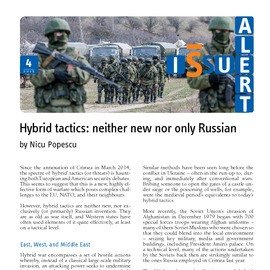Since the annexation of Crimea in March 2014, the spectre of ‘hybrid’ tactics (or threats) is haunting both European and American security debates. This seems to suggest that this is a new, highly effective form of warfare which poses complex challenges to the EU, NATO, and their neighbours. However, hybrid tactics are neither new, nor exclusively (or primarily) a Russian invention. They are as old as war itself, and Western states have often used elements of it quite effectively, at least on a tactical level.
East, West, and Middle East
Hybrid war encompasses a set of hostile actions whereby, instead of a classical large-scale military invasion, an attacking power seeks to undermine its opponent through a variety of acts including subversive intelligence operations, sabotage, hacking, and the empowering of proxy insurgent groups. It may also spread disinformation (in target and third countries), exert economic pressure and threaten energy supplies. In order to be successfully executed, a degree of integration between these elements is required, as is their subordination to some sort of strategic command. It is also imperative that the aggressor be in a position to plausibly deny having supported these actions to the local and international communities.
Similar methods have been seen long before the conflict in Ukraine – often in the run-up to, during, and immediately after conventional wars. Bribing someone to open the gates of a castle under siege or the poisoning of wells, for example, were the medieval equivalents to today’s hybrid tactics. More recently, the Soviet Union’s invasion of Afghanistan in December 1979 began with 700 special forces troops wearing Afghan uniforms – many of them Soviet Muslims who were chosen so that they could blend into the local environment – seizing key military, media and government buildings, including President Amin’s palace. On a technical level, many of the actions undertaken by the Soviets back then are strikingly similar to the ones Russia employed in Crimea last year.
The US has also made effective use of hybrid tactics: notably against the Soviet Union in Afghanistan in the 1980s, and then again immediately before its attempt to dislodge the Taliban with Operation Enduring Freedom in 2001. But the US has also suffered many casualties as a result of this type of warfare – in Afghanistan itself and also in Iraq. What military experts call ‘asymmetric’ warfare could also fall into this category. In Lebanon, for example, Hizbullah went from mounting traditional guerrilla operations during the country’s civil war to making use of hybrid warfare during its conflict with the Israeli army in 2006.
That such tactics – long part of Russia’s military doctrine and debates – were employed in Ukraine is no big surprise. What was impressive is that Russia managed to assemble and deploy the various elements in near perfect coordination. There are people in Russia, Ukraine and even the West who still think that the “little green men” who took over Crimea were locals – even months after Putin himself acknowledged that Russian troops were indeed present.
Conventional vs. hybrid
For countries like Ukraine, hybrid warfare is a tangible threat, but for most European states it poses less of a danger. Such tactics worked so well in parts of eastern Ukraine because it is hard to imagine a more favourable ground: a contested, passive or near-absent sense of Ukrainian identity, estrangement from the new authorities in Kiev, a large-scale Russian military and intelligence presence in Sevastopol, and the domination of Russia-based media outlets. Due to this climate, for it was not just easy for Russia; it was almost effortless.
Such conditions, however, are unlikely to be replicated on a comparable scale elsewhere. It should also be acknowledged that Ukraine also eventually managed to strike back. Hybrid war was possible between late February and mid-May 2014, immediately after Yanukovich fled and Ukraine lacked a functioning government which could effectively command the police, intelligence services and army. Russian volunteers and (most probably) intelligence operatives simply filled the void and in doing so were able to take over swathes of territory. For its part, Moscow amassed its armed forces along the border with Ukraine to dissuade Kiev from opting for a largescale military response.
By mid-May 2014, however, the Ukrainians were able to put up a certain level of resistance, and, after Poroshenko’s election, launched a conventional military campaign which helped them recapture almost half of the territory initially lost. Although the Ukrainian army was weak, disorganised and demotivated, and pro-Ukrainian volunteer groups under-equipped, they nevertheless managed to significantly roll back the separatists between June and August.
This forced Moscow to drop its hybrid tactics in favour of conventional methods of aggression, such as shelling Ukrainian territory and sending troops across the border under the guise of being ‘volunteers’. Ever since, the conflict has not been hybrid at all (as the current rebel offensive to take Mariupol also proves). One reason why hybrid war is so dangerous and potentially destabilising is that it is easy and cheap to launch for external aggressors, but costly in various ways for the defenders. While an attacker can try and hide behind plausible deniability, those responding are immediately placed in the spotlight. The Ukrainian army’s assault using heavy weaponry – rather than surgical urban warfare – on rebel areas caused a large number of civilian casualties. This had the effect of both alienating the central government from people in the east of the country and damaging its reputation abroad. Were it not for the tragedy of the MH-17 flight, allegedly shot down by the Donbas separatists, the international community would have probably been much more focused on the conduct of the war by Kiev.
Between the Alliance and the Union
It still appears highly unlikely that Russia will attempt to start seizing chunks of NATO members’ territory with “little green men”. But attempts to destabilise governments and embarrass both the EU and NATO through low-scale operations – what some call ‘poking and probing’ – are not inconceivable. Responding effectively to hybrid tactics in Europe would require a coordinated approach from both organisations. The Alliance can take action, primarily, in the military and intelligence fields – through deterrence and, if necessary, direct intervention. But the very nature of the threat requires a wider array of tools: well-trained police forces, functioning border management systems, and effective anti-corruption agencies, as well as transparency in the energy sector and in party political funding. It is here that the Union can make a real difference in contributing to a combined and integrated response.
Neither the Alliance nor the Union can guarantee the absolute security of their partners in the face of future threats, but they can, however, help them build resilience to hybrid tactics.
– – – – –
View this article at EUISS here and ISN here | PDF
© EUISS [Alert No. 4, 1/30/15]










